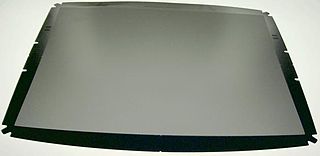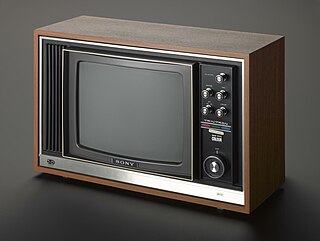
A cathode-ray tube (CRT) is a vacuum tube containing one or more electron guns, which emit electron beams that are manipulated to display images on a phosphorescent screen. The images may represent electrical waveforms (oscilloscope), pictures, radar targets, or other phenomena. A CRT on a television set is commonly called a picture tube. CRTs have also been used as memory devices, in which case the screen is not intended to be visible to an observer. The term cathode ray was used to describe electron beams when they were first discovered, before it was understood that what was emitted from the cathode was a beam of electrons.

The shadow mask is one of the two technologies used in the manufacture of cathode-ray tube (CRT) televisions and computer monitors which produce clear, focused color images. The other approach is the aperture grille, better known by its trade name, Trinitron. All early color televisions and the majority of CRT computer monitors used shadow mask technology. Both of these technologies are largely obsolete, having been increasingly replaced since the 1990s by the liquid-crystal display (LCD).

Trinitron was Sony's brand name for its line of aperture-grille-based CRTs used in television sets and computer monitors, one of the first television systems to enter the market since the 1950s. Constant improvement in the basic technology and attention to overall quality allowed Sony to charge a premium for Trinitron devices into the 1990s.
Apple Inc. has sold a variety of LCD and CRT computer displays. Apple paused production of their own standalone displays in 2016 and partnered with LG to design displays for Macs. In June 2019, the Pro Display XDR was introduced, however it was expensive and targeted for professionals. Nearly three years later, in March 2022, the Studio Display was launched as a consumer-targeted counterpart to the professional monitor. These two are currently the only Apple-branded displays available.

Dot pitch is a specification for a computer display, computer printer, image scanner, or other pixel-based devices that describe the distance, for example, between dots (sub-pixels) on a display screen. In the case of an RGB color display, the derived unit of pixel pitch is a measure of the size of a triad plus the distance between triads.
In cathode-ray tube (CRT) terms, a triad is a group of 3 phosphor dots coloured red, green, and blue on the inside of the CRT display of a computer monitor or television set. By directing differing intensities of cathode rays onto the 3 phosphor dots, the triad will display a colour by combining the red, green and blue elements. However, triads are not pixels, and multiple triads will form one logical pixel of the displayed image.

The display resolution or display modes of a digital television, computer monitor or display device is the number of distinct pixels in each dimension that can be displayed. It can be an ambiguous term especially as the displayed resolution is controlled by different factors in cathode ray tube (CRT) displays, flat-panel displays and projection displays using fixed picture-element (pixel) arrays.

WEGA was a German audio and video manufacturer, manufacturing some of Germany's earliest radio receivers.

A surface-conduction electron-emitter display (SED) was a display technology for flat panel displays developed by a number of companies. SEDs used nanoscopic-scale electron emitters to energize colored phosphors and produce an image. In a general sense, a SED consists of a matrix of tiny cathode-ray tubes, each "tube" forming a single sub-pixel on the screen, grouped in threes to form red-green-blue (RGB) pixels. SEDs combine the advantages of CRTs, namely their high contrast ratios, wide viewing angles, and very fast response times, with the packaging advantages of LCD and other flat panel displays.
Cromaclear is a trademark for CRT technology used by NEC during the mid to late-90s. This adopted the slotted shadow mask and in-line electron gun pioneered by the 1966 GE Porta-Color and used by most then-current television tubes to computer monitor use. It was claimed that Cromaclear could offer the image clarity and sharpness of the Trinitron and Diamondtron aperture grille CRTs without the disadvantages e.g. expense and the horizontal damping wires.
The penetron, short for penetration tube, is a type of limited-color television used in some military applications. Unlike a conventional color television, the penetron produces a limited color gamut, typically two colors and their combination. Penetrons, and other military-only cathode ray tubes (CRTs), have been replaced by LCDs in modern designs.

FD Trinitron/WEGA is Sony's flat version of the Trinitron picture tube. This technology was also used in computer monitors bearing the Trinitron mark. The FD Trinitron used computer-controlled feedback systems to ensure sharp focus across a flat screen. The FD Trinitron reduces the amount of glare on the screen by reflecting much less ambient light than spherical or vertically flat CRTs. Flat screens also increase total image viewing angle and have less geometric distortion in comparison to curved screens. The FD Trinitron line featured key standard improvements over prior Trinitron designs including a finer pitch aperture grille, an electron gun with a greater focal length for corner focus, and an improved deflection yoke for color convergence. Sony would go on to receive an Emmy Award from the National Academy of Television Arts and Sciences for its development of flat screen CRT technology.

A raster scan, or raster scanning, is the rectangular pattern of image capture and reconstruction in television. By analogy, the term is used for raster graphics, the pattern of image storage and transmission used in most computer bitmap image systems. The word raster comes from the Latin word rastrum, which is derived from radere ; see also rastrum, an instrument for drawing musical staff lines. The pattern left by the lines of a rake, when drawn straight, resembles the parallel lines of a raster: this line-by-line scanning is what creates a raster. It is a systematic process of covering the area progressively, one line at a time. Although often a great deal faster, it is similar in the most general sense to how one's gaze travels when one reads lines of text.

Large-screen television technology developed rapidly in the late 1990s and 2000s. Prior to the development of thin-screen technologies, rear-projection television was standard for larger displays, and jumbotron, a non-projection video display technology, was used at stadiums and concerts. Various thin-screen technologies are being developed, but only liquid crystal display (LCD), plasma display (PDP) and Digital Light Processing (DLP) have been publicly released. Recent technologies like organic light-emitting diode (OLED) as well as not-yet-released technologies like surface-conduction electron-emitter display (SED) or field emission display (FED) are in development to replace earlier flat-screen technologies in picture quality.

A vector monitor, vector display, or calligraphic display is a display device used for computer graphics up through the 1970s. It is a type of CRT, similar to that of an early oscilloscope. In a vector display, the image is composed of drawn lines rather than a grid of glowing pixels as in raster graphics. The electron beam follows an arbitrary path, tracing the connected sloped lines rather than following the same horizontal raster path for all images. The beam skips over dark areas of the image without visiting their points.
The Chromatron is a color television cathode ray tube design invented by Nobel prize-winner Ernest Lawrence and developed commercially by Paramount Pictures, Sony, Litton Industries and others. The Chromatron offered brighter images than conventional color television systems using a shadow mask, but a host of development problems kept it from being widely used in spite of years of development. Sony eventually abandoned it in favor of their famous Trinitron system using an aperture grille.
The Geer tube was an early single-tube color television cathode ray tube, developed by Willard Geer. The Geer tube used a pattern of small phosphor-covered three-sided pyramids on the inside of the CRT faceplate to mix separate red, green, and blue signals from three electron guns. The Geer tube had a number of disadvantages and was never used commercially due to the much better images generated by RCA's shadow mask system. Nevertheless, Geer's patent was awarded first, and RCA purchased an option on it in case their own developments didn't pan out.
The beam-index tube is a color television cathode ray tube (CRT) design, using phosphor stripes and active-feedback timing, rather than phosphor dots and a beam-shadowing mask as developed by RCA. Beam indexing offered much brighter pictures than shadow-mask CRTs, reducing power consumption, and as they used a single electron gun rather than three, they were easier to build and required no alignment adjustments.

General Electric's Porta-Color was the first "portable" color television introduced in the United States in 1966.
Telechrome was the first all-electronic single-tube color television system. It was invented by well-known Scottish television engineer, John Logie Baird, who had previously made the first public television broadcast, as well as the first color broadcast using a pre-Telechrome system.
















